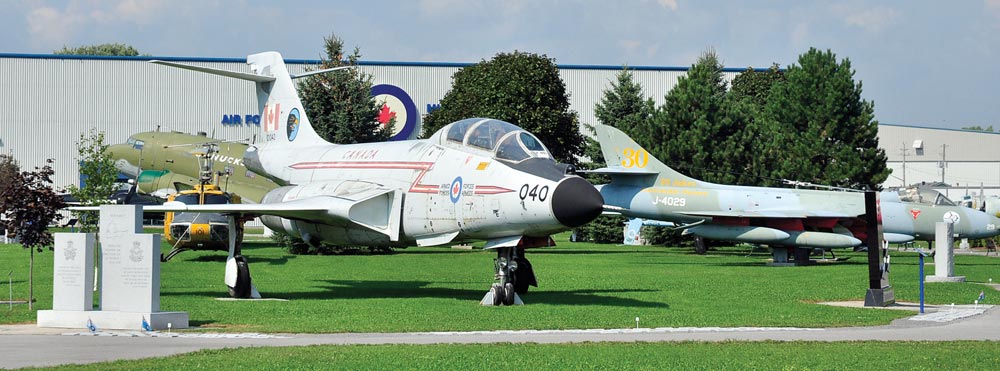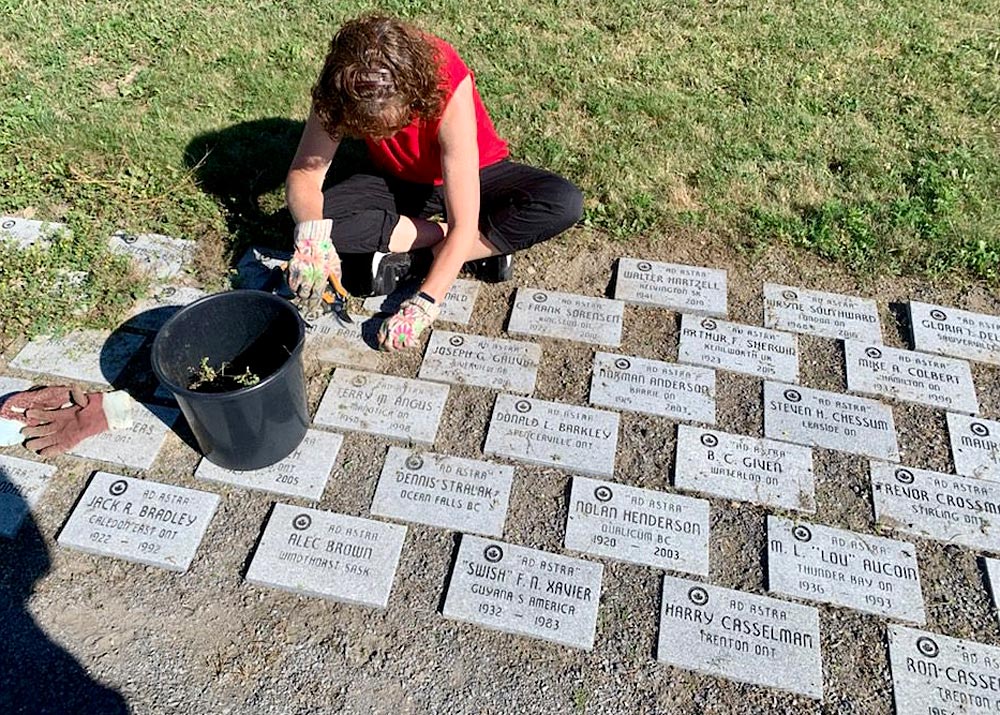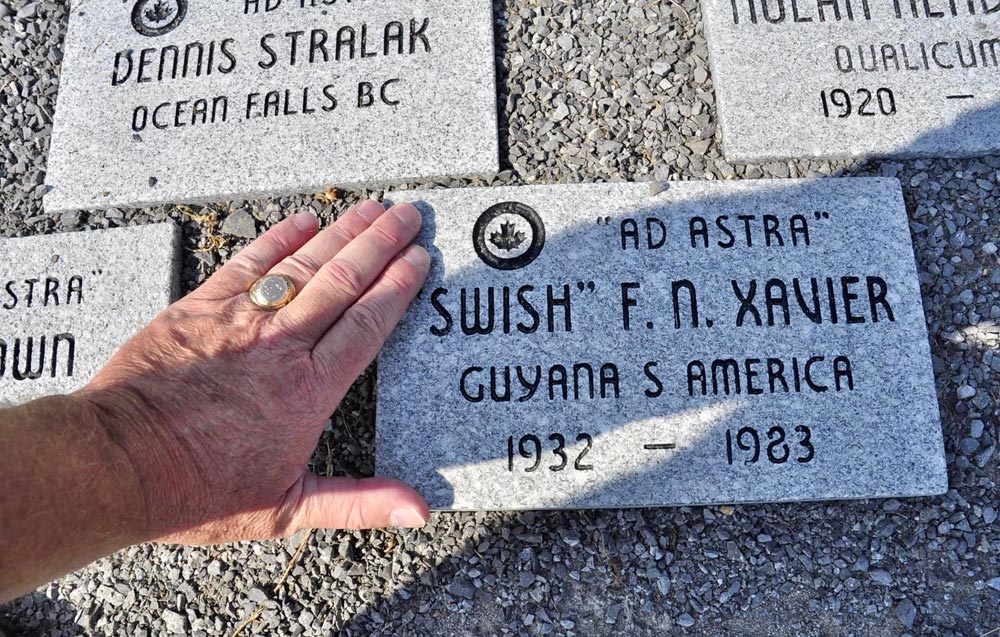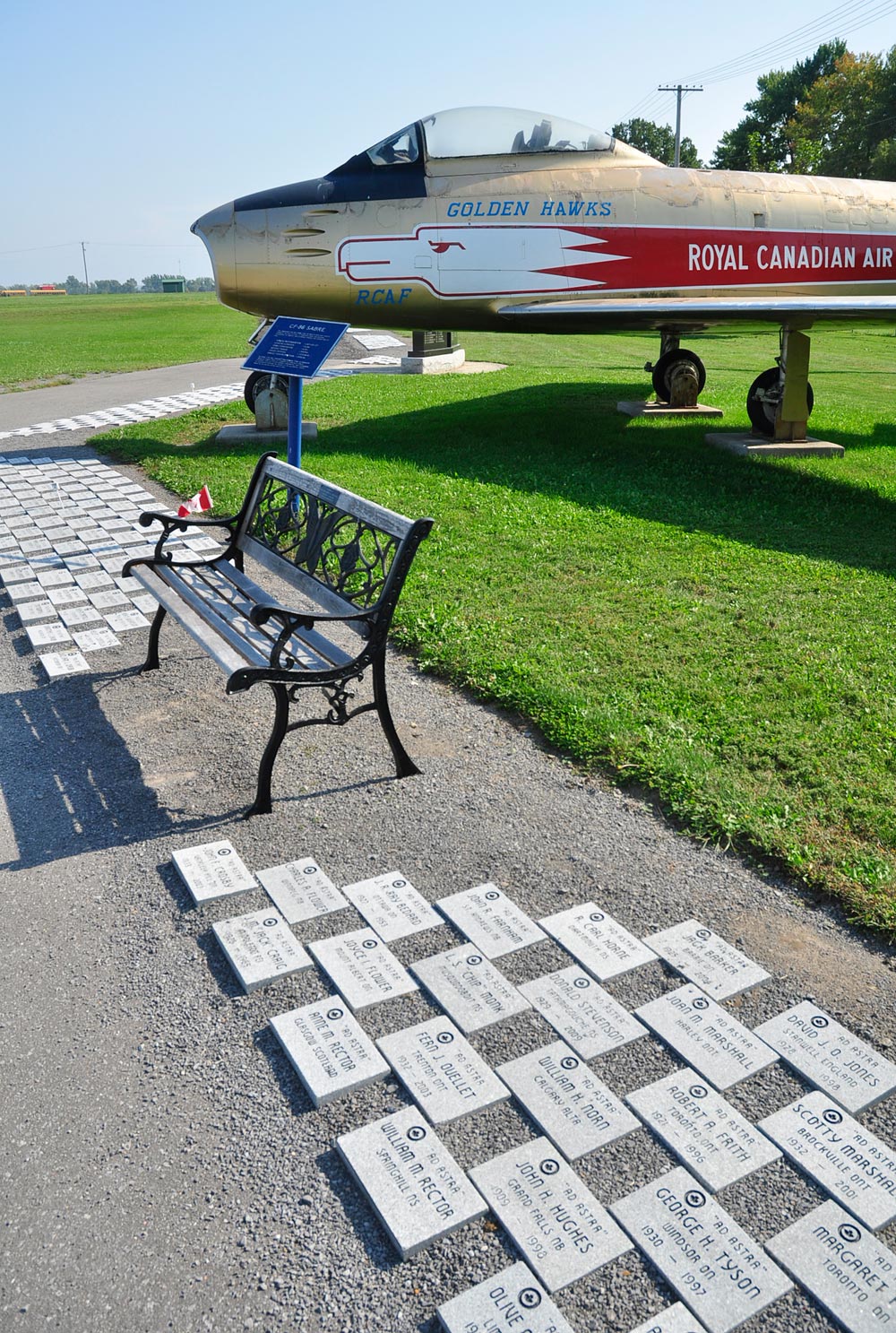
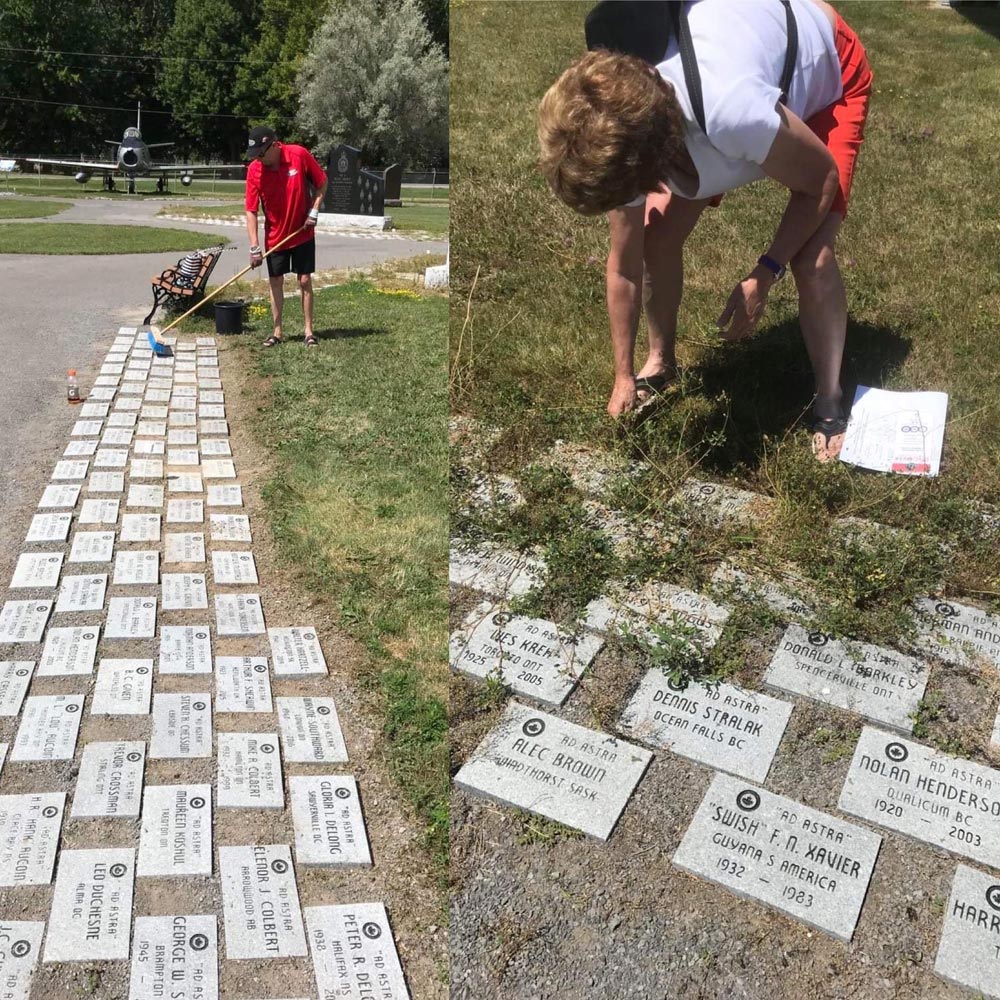
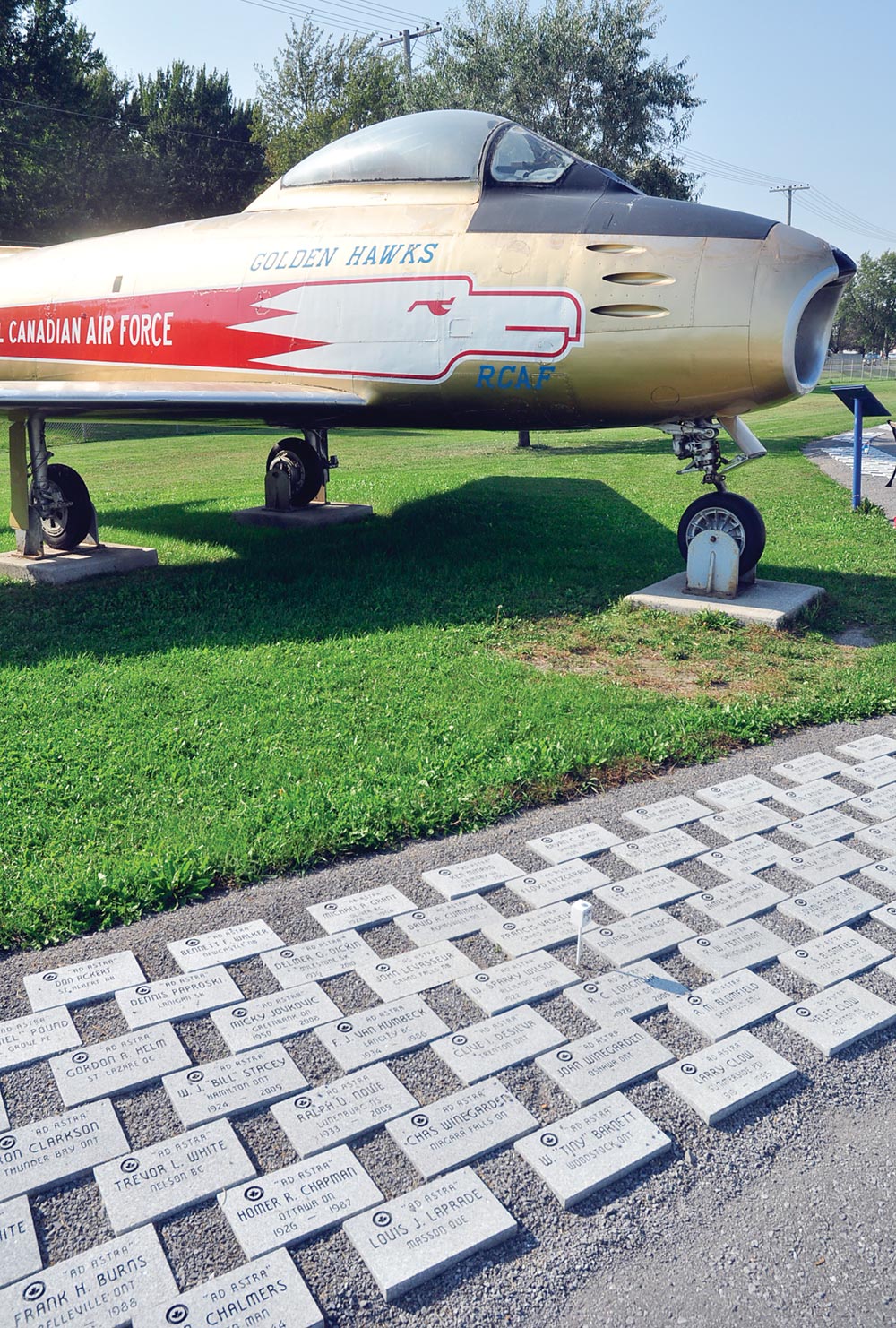
Jules Xavier
Shilo Stag
Air force veterans from Manitoba are in good company at 8 Wing CFB Trenton.
Of the more than 12,000 stone markers set along the edges of walkways adjacent to the Ontario-based National Air Force Museum of Canada, there are a few of them featuring people with a connection to this province.
Their names are engraved on the grey granite stone’s facade such as Andrew Mynarski (1916-1944) and Robert Caswill (1915-2002), both of Winnipeg; Alan McLeod (1899-1918) of Stonewall; and William Barker (1894-1930) of Dauphin.
The motto for the Ad Astra program is “A flower fades … a stone never.”
The outdoor portion of the museum referred to as the RCAF Memorial Airpark features a variety of military aircraft which have been retired from active service or were donated by the United States, Germany and even the former Soviet Union.
“No question, to say the reception the Ad Astra stones have received exceeds our most optimistic expectations would be an understatement,” said retired BGen Jeff Brace, the museum’s inaugural executive director when it first opened.
The program has blossomed since its inception in January 1996 thanks to media attention and word of mouth, according to Brace. He said in the first nine months of the program when the cost was $100, 752 stones were installed of the 975 granite stones sold and ordered that inaugural year. The current cost is $160.
“People have purchased stones for themselves, as gifts, or in memory of a loved one,” he said. “[The stones] are a perpetuation of history and tradition of those who served and a dedication to the men and women who died while serving their country.”
Brace would like to see more RCAF participation from Canada’s western provinces, where RCAF members have served, including 17 Wing in Winnipeg and RCAF members posted to Army training locations like CFB Shilo.
The museum is working with the media and Royal Canadian Legion to spread the word across Canada, perhaps piquing the interest of a family member who might want to honour their grandparents or parents if they served with the RCAF in the First and Second World Wars, Korea War and more recently Afghanistan. Bearing the words Ad Astra, which means “To The Stars,” each 14-centimetre by 25-centimetre by seven-millimetre marker reflects an Air Force Roundel, a person’s name, his or her hometown and province and the years of birth and death.
“If the individual is still living we don’t put the birth year on until after we’ve been notified of their death,” Brace said.
The cost of this second engraving following a death is covered by the museum.
The idea for the fundraising project was proposed and developed by retired Col Cy Yarnell. The Ad Astra stone program is something which brings past, present and future members of Canada’s Air Force and their families together.
Monuments date back to the Scottish Clans who had a sacred monument called the Cairn of Remembrance. It was but a loose pile of granite stones thrown together at the top of a Heather Hill, but every stone had precious worth.
Throughout the generations, as the clans went forth to battle, each man took a granite stone and placed it on the cairn. When he came back, he took his stone away and the stones that were left were in memory of those who would never return.
The museum hosts a stone dedication ceremony every September to recognize the new Ad Astra stones, which have been placed in the earth.
CFB Shilo military personnel with the RCAF and Manitoba residents interested in the Ad Astra stone program can visit www.airforcemuseum.ca, where you can upload an application form. Or call 1-613-965-2208.
Eligibility criteria for obtaining an Ad Astra stone varies:
• Any person who has served, or is now serving, in any of Canada’s air forces – RCAF, CAF, CF air element.
• Any Canadian who, prior to the formation of the CAF, served in the RFC or RNAS.
• Any Canadian who has served, or who is now serving, in an allied air force.
• The spouse of any person who is eligible under the above criteria.
• Foreign military persons assigned for duty with Canada’s air force in the past or present.
“We also will attempt to accommodate requests for specific locations in the air park,” Brace said.
A stone marker can be placed along the walkway or near an aircraft — like the defunct CF101 Voodoo or submarine hunter Argus which flew out of CFB Comox and Greenwood before each was retired by the RCAF, or a MIG-21 that patrolled the sky above East Germany during the Cold War — among those on display.
There’s also a Hercules, Dakota, F18 Hornet, Starfighter and Labrador helicopter among the outdoor static displays adjacent to the National Air Force Museum of Canada.
Of note, the stones will not display an individual’s rank. This is done so everyone is remembered equally, whether you were a captain or a sergeant.
Personal information regarding service number, rank and military decorations are maintained in a museum register.
IN BRIEF
• The Ad Astra Stone ceremony is an annual event at the museum, held in the RCAF Memorial Airpark. On the last Saturday of September, stones added to the park in the past year are dedicated and all Ad Astra stones are recognized and honoured.
It is held in collaboration with the RCAF Association and 8 Wing/CFB Trenton. Approximately 300 to 400 stones are dedicated each year. Currently, there are more than 12,000 stones on display. Guests from across the country and even around the globe, gather to pay tribute to those named on the stones and to all who have and who continue to serve in Canada’s Air Force.
• Precisely at 2 p.m., the call of pipes and drums herald the arrival of a large colour guard, dignitaries, and honoured guests. Guest speakers are invited to address the audience on the current year’s theme. Previous themes have included British Commonwealth, Air Training Plan and Bomber Command, as well as 424, 435, 436, 437 and 400 Squadron anniversaries. The afternoon is concluded with a blessing of all stones and a fly-past, courtesy of 8 Wing/CFB Trenton.
• Museum executive director Chris Colton advised, “While we’ve come close, the Ad Astra Ceremony has never been rained out. The museum does an unbelievable job of keeping the Air Force memory alive. Through the Ad Astra stone program, we can now count over 12,000 stories that are waiting to be told … the successes of today’s Air Force continue to honour the pioneers who opened our skies and whose names we see all around us today. It is always very satisfying to receive so many positive comments and expressions of gratitude for the opportunity to gather with friends and family and remember Air Force veterans both past and present.”
• This annual event is open to the community and families and friends of Ad Astra Stone recipients are encouraged to attend.
• The Ad Astra program was introduced in 1996 and has proven to be enormously popular and successful. Individual stones made of granite bear the engraved inscription “Ad Astra” (to the stars), the Air Force Roundel, and the name, hometown, province and dates of birth and death of the person honoured.
• For a donation of $160, a stone will be placed in the Airpark in commemoration of any person who has served or is serving in the CAF, their spouse, or a Canadian citizen who has or is serving with an allied force in an air force capacity.
An annual clean-up, weeding around the Ad Astra stones, is part of the park where defunct military airplanes and helicopters are put on display at CFB Trenton. Stag editor Jules Xavier’s father is among the first stones placed adjacent to the Voodoo in 1996. Photos Jules Xavier/Shilo Stag
